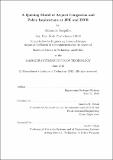A queuing model of airport congestion and policy implications at JFK and EWR
Author(s)
Jacquillat, Alexandre
DownloadFull printable version (6.094Mb)
Other Contributors
Massachusetts Institute of Technology. Technology and Policy Program.
Advisor
Amedeo R. Odoni.
Terms of use
Metadata
Show full item recordAbstract
Since the phasing-out of the High Density Rule, access to major commercial airports in the United States has been unconstrained or, in the case of the airports of New York, weakly constrained. This largely unregulated demand combined with capacity constraints led to record delay levels in 2007, whose costs were estimated as in excess of $30 billion a year. Mitigating airport congestion may be achieved through demand management measures. Quantifying the benefits of such measures requires careful modeling of flight delays as a function of flight schedules. This thesis applies a stochastic and dynamic queuing model to analyze operations at JFK and Newark (EWR), two of the most congested airports in the United States. Two models are used to approximate the dynamics of the queuing system: a numerical model called DELAYS and a new Monte Carlo simulation model, which combines time-varying stochastic models of demand and capacity. These two models are then calibrated and validated using historical records of operations. In particular, they provide estimates of the average throughput rate at JFK and EWR under different weather conditions. The models are then shown to predict accurately both the magnitude of the delays and their evolution over the course of a day of operations. In addition, the Monte Carlo simulation model evaluates reasonably well the variability of the delays between successive days of operations. These two models are then applied to a study of recent trends in scheduling and ontime performance at JFK and EWR. The analysis indicates that the significant delay reductions observed between 2007 and 2010 can be largely attributed to the relatively small reduction of airport demand over this period. In particular, it demonstrates the strongly nonlinear relationship between demand and delays when airports operate close to capacity. It also shows that, for a given daily number of flights, the more evenly they are distributed in a day, the lower the resulting delays are likely to be.
Description
Thesis (S.M. in Technology and Policy)-- Massachusetts Institute of Technology, Engineering Systems Division, Technology and Policy Program, 2012. This electronic version was submitted by the student author. The certified thesis is available in the Institute Archives and Special Collections. Cataloged from student submitted PDF version of thesis. Includes bibliographical references (p. 119-121).
Date issued
2012Department
Massachusetts Institute of Technology. Engineering Systems Division; Technology and Policy ProgramPublisher
Massachusetts Institute of Technology
Keywords
Engineering Systems Division., Technology and Policy Program.